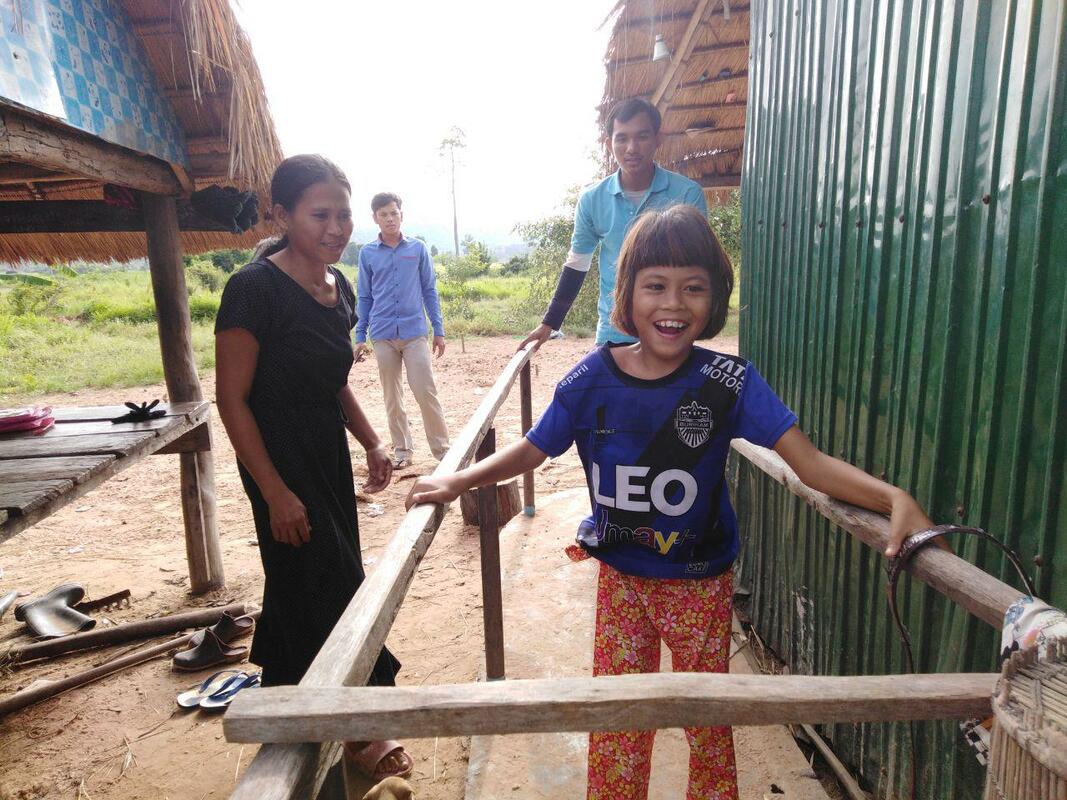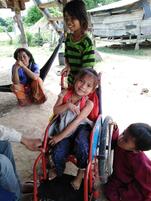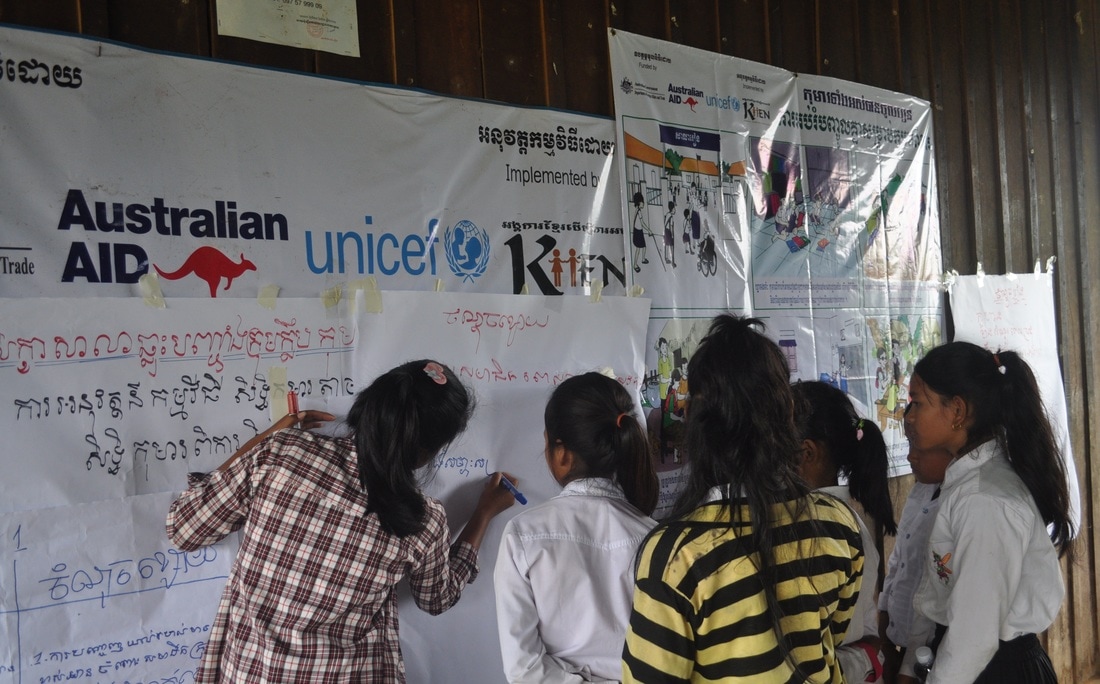Prev Project 4 of 4 Next Project
Copyright Notice: All project content (including, but not limited to, text and images) is owned by KHEN and subject to copyright regulations. In accordance with these copyright regulations, our terms and conditions and Child Protection Policy, please do not copy or reuse images or any other content from this site. View full terms and conditions
SHORT TITLEInclusive
PROJECT TITLEEnsuring Inclusive Education for Children with Disabilities (within Samlout and Rukhak Kiri Projects) (Cambodia Disability Inclusive Development Fund (CDIDF)
PROJECT FOCUS AREASFUNDERSPARTNERS |
PROJECT DESCRIPTION
KHEN wants to build on the two education projects currently operated.(i.e. Rukhak Kiri project and Samlout Project) and create synergies that will benefit children with disability (CwDs).
We want to:
Objectives:
We want to:
- Find the “hidden” children – mostly children with disabilities – and get them the support they need to be able to access the type of education that best meets their requirements;
- Increase the capacity of communities and schools to create child friendly environments for children with disability (CwD) and support these children to attend school and fully participate in both formal and non-formal education opportunities;
- Change staff, schools and communities’ perceptions of children/people with disabilities to a more positive view - focus on what people can do rather on what they can’t – so that they are valued and supported in the same way as people without disabilities;
- Build the capacity of school and community based organisations - School Supporting Committees (SSC) and Community Councils for Women and Children (CCWCs) so that after the project has finished, people will continue to support children (and adults) with disabilities;
- Improve KHEN’s capacity to work with and for people with disabilities – as a Rights Based organisation.
Objectives:
- Specific Objective 1 – By end of 2017, identified CwDs in 25 target schools have access to schooling which meets their needs.
- Specific Objective 2 – 4 Commune Investment Plans (CIPs) include actions and funds to support Children with Disability (CwDs)
- Specific Objective 3 – KHEN effectively supports inclusive education in Battambang Province through the Provincial Education Sector Working Group (Provincial Education Sector Working Group)
- Specific Objective 4 – Effective and efficient program management
WHAT PROBLEM / SITUATION DOES THE PROJECT AIM TO ADDRESS
People with disabilities are not always valued or respected in these remote communities. A disability can be seen as having done something wrong in a past life and the greater the disability the greater the “wrong doing”. It can be considered “fate” about which nothing can or should be done and in many cases, people are ashamed of family members with a disability. As a result of this, children and adults with disabilities are not always:
KHEN work with the Department of Education (DoE), Local Authorities, and Commune Committee for Women and Children (CCWC) to find children with disabilities (CwDs) who are not going to school and give them access to education, and the support and care they need to reach their full potential.
Education is not highly valued by these communities. There are a number of reasons for this including: many community members don’t see any benefits of education as they have had little or no education; despite lack of education, community members have still managed to have a livelihood and raise families. Another factor is that Samlot was a stronghold of the Khmer Rouge and Rukhak Kiri has many former Khmer Rouge members. The Khmer Rouge was dismissive of education and aggressive towards those who were educated, i.e. teachers were targeted and killed.
KHEN is working in these target communities to see people in these communities to value education for everyone.
Despite the Education for All strategy, the Ministry of Education has limited resources to schools and teachers in these districts. This is compounded by the fact that there is also little technical support for the development of curriculum and teacher training manuals for children with intellectual disabilities and receive little support from the Department of Social Affairs, Youth and Rehabilitation – there is only one official in each district to support people with disabilities (PwD). Lack of budget and human resources are the main reasons given for this.
- acknowledged or recorded in official records (some are literally hidden);
- provided with the care and support they need for a healthy, safe & productive life;
- provided with opportunities, including access to education, which would enable them to fulfil their potential.
KHEN work with the Department of Education (DoE), Local Authorities, and Commune Committee for Women and Children (CCWC) to find children with disabilities (CwDs) who are not going to school and give them access to education, and the support and care they need to reach their full potential.
Education is not highly valued by these communities. There are a number of reasons for this including: many community members don’t see any benefits of education as they have had little or no education; despite lack of education, community members have still managed to have a livelihood and raise families. Another factor is that Samlot was a stronghold of the Khmer Rouge and Rukhak Kiri has many former Khmer Rouge members. The Khmer Rouge was dismissive of education and aggressive towards those who were educated, i.e. teachers were targeted and killed.
KHEN is working in these target communities to see people in these communities to value education for everyone.
Despite the Education for All strategy, the Ministry of Education has limited resources to schools and teachers in these districts. This is compounded by the fact that there is also little technical support for the development of curriculum and teacher training manuals for children with intellectual disabilities and receive little support from the Department of Social Affairs, Youth and Rehabilitation – there is only one official in each district to support people with disabilities (PwD). Lack of budget and human resources are the main reasons given for this.
SPECIFIC PROJECT ACTIVITIES
Work in partnership with P/DOE and strengthening commitment by P/DoE to pre & primary school education for children with disabilities demonstrated by: -
In schools and facilitated with School Supporting Committee:
In communities and facilitated with Commune Council for Women and Children (CCWC) and strengthening commitment by communities to create and support CwDs - in partnership with local authorities, schools and NGOs - demonstrated by:-
With other NGOs:
Note: this is a list of a few of the key project activities, many more exist.
- Multiple workshops to build school/teacher capacity to cater for and teach children with disabilities; (i.e. teacher training on teaching and supporting CwDs for general and life skills subjects (with community involvement so together everyone learns about health, nutrition & hygiene), Capacity development for teachers in inclusive education practices for formal education - for both physical and intellectual disabilities. Teacher aid training on helping CwD's in the classroom)
- Multiple workshops with School Supporting Committees to support children with disabilities in school and include in school development plans; and
- School environments which meet the needs of children with disabilities in line with the MoE/Child Friendly dimensions.
- Assisting in creating school environments which meet the needs of children with disabilities in line with the MOE/Child Friendly dimensions.
- Incorporate the specific needs of disadvantaged students (poor, disabled, minority, and girls) into the School Development Planning Process by conducting multiple workshops with School Supporting Committees.
In schools and facilitated with School Supporting Committee:
- Capacity development on inclusion and mainstreaming of CwD/PwD (Person with Disability) in the schools, linking to local Child Based Rights groups and the formation of Sub-Committees for Disadvantaged Children (SCDC).
- Identify and provide specific support to increase accessibility to school facilities for students
- Home visits, and special activities within the school.
In communities and facilitated with Commune Council for Women and Children (CCWC) and strengthening commitment by communities to create and support CwDs - in partnership with local authorities, schools and NGOs - demonstrated by:-
- promotion of and support for inclusive education from preschool to high school and informal and vocational education.
- official records (including birth certificates, ID poors). Identification of all Children with Disabilities, their specific needs including the support required to enable them to attend school
- Collect comprehensive statistics, through the house group mapping and enrollment campaigns, of the nature of disability and the problems the disabled face in the school community.
- Capacity development on creating child friendly environments for CwDs
- Capacity development for parenting for effective care and advocacy for CwDs
- Obtain agreement from the Commune Council to support CwD school attendance
- Provision of healthy & safe community environments,
- Increased access to disability related services.
With other NGOs:
- Source other expertise required to assist with disability issues and to build capacity in a Rights Based Approach for Children and People with Disabilities. networking and synergy approaching for complimentary working.
Note: this is a list of a few of the key project activities, many more exist.
DIRECT BENEFICARIES
- 250 Children in 250 families with disabilities in rural areas
- 100 Adults with disabilities in rural areas
- 1450 Children aged 0 - 17 (600 girls) in rural areas
- 1,990 Adults (595 Female) in rural areas
- 5 direct/5 Self Help Groups/parents groups
- 25 groups of Youth/Child Club Leaders Helping CwDs in Education
- 100 teachers in pre-classes and primary schools (25 schools)
INDIRECT BENEFICARIES
- 300 Adults with disabilities in rural areas
- 3,150 Children aged 0 - 17 (1150 girls) in rural areas
- 8,000 Adults (2150 Female) in rural areas
- 60% of each target community population (25 communitiies)
DURATION
3 and Half Years, Starting Jan 2015 and Completing December 2018








